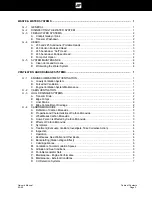
Owners Manual
05/00
Section B
Page 2
2. Use extreme caution while operating the engine in
confined areas such as enclosed slips or congested
piers. Operation under such conditions could easily
lead to exhaust gasses (carbon monoxide) entering
even though you may have all the hatches, windows,
doors and portholes closed.
3. Persons sleeping can be easily overcome by car-
bon monoxide because they are unaware of its pres-
ence. Sleeping while the engine is running is not
recommended. If persons are sleeping aboard while
underway, those awake should monitor for carbon
monoxide accumulation in the cabin; especially the
sleeping areas.
NEVER operate the propulsion engine while
everyone on-board is sleeping. Fatal carbon
monoxide poisoning can occur.
For additional information, refer to Section H-4 Carbon
Monoxide.
B - 3
ENGINES
Consult the Engine Owners Manual included in the
owners packet for additional operation and maintenance
information.
B - 4
PROPELLERS
Knowledge of the propeller is most easily gained through
better understanding of the terminology used to refer to
the aspects of propeller size and performance.
NOTICE
Never run with a damaged propeller. You can
damage the engine or drive unit. Keep a spare
propeller on board.
A. Diameter
Diameter is twice the distance from the center of the
prop shaft to the extreme tip of a propeller blade. In-
creasing or decreasing propeller size will have a direct
bearing on the RPMs an engine will develop. This is
due to the greater amount of propeller blade surface in
contact with the water. See Figure B1.
B. Pitch
Pitch is a measure of helix angle, or angle of attack, of
the rotating blade. Pitch is easily understood if one imag-
ines the propeller rotating through a semisolid such as
butter or jello. The distance the propeller will travel in
one revolution is called Pitch. Increasing or decreas-
ing pitch will also have a direct bearing on engine RPMs
because of the greater bite taken by the blade with each
rotation. See Figure B1.
Figure B1: Propeller Pitch & Diameter
C. Prop Slip
When traveling through water a propeller is unable to
get a complete bite because of the fluidity of water. Prop
Slip is usually expressed as a percent of the computed
theoretical speed. Fifteen to twenty-five percent prop
slip is common for a sport-type boat operating at cruis-
ing speed.
Summary of Contents for Horizon 200
Page 1: ......
Page 56: ...Owner s Manual 05 00 Section G Page 6 Figure G7 General Water System Diagram WATER SYSTEM ...
Page 80: ...Owner s Manual 05 00 Section J Page 15 Figure J16 Skiing Signals ...
Page 131: ...Owner s Manual 05 00 Fuel Log Page 1 FUEL LOG DATE HOURS RUN FUEL GAL RANGE MILES RPM MPH GPH ...
Page 132: ...Owner s Manual 05 00 Fuel Log Page 2 FUEL LOG DATE HOURS RUN FUEL GAL RANGE MILES RPM MPH GPH ...
Page 133: ...Owner s Manual 05 00 Fuel Log Page 3 FUEL LOG DATE HOURS RUN FUEL GAL RANGE MILES RPM MPH GPH ...
Page 134: ...Owner s Manual 05 00 Service Log Page 1 SERVICE LOG DATE HOURS MAINTENANCE PERFORMED ...
Page 135: ...Owner s Manual 05 00 Service Log Page 2 SERVICE LOG DATE HOURS MAINTENANCE PERFORMED ...
Page 136: ...Owner s Manual 05 00 Service Log Page 3 SERVICE LOG DATE HOURS MAINTENANCE PERFORMED ...
Page 138: ...Page 1 1998 1999 MODEL YEAR 200 HORIZON 245 SUNDOWNER Electrical Schematics ...
Page 140: ......






























